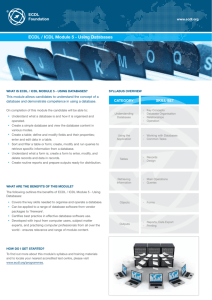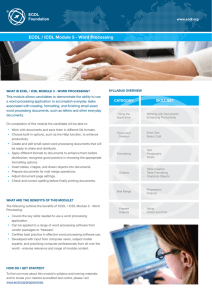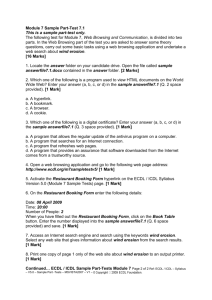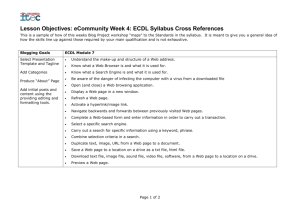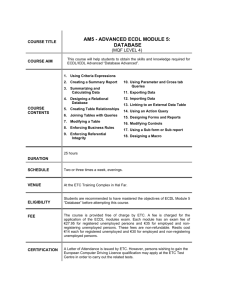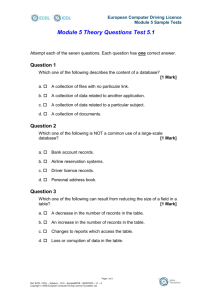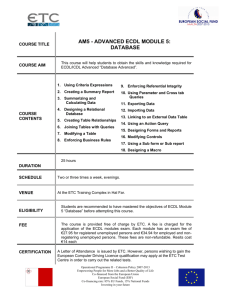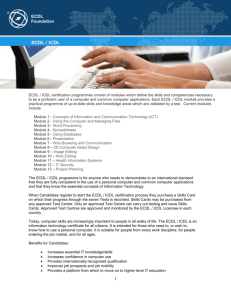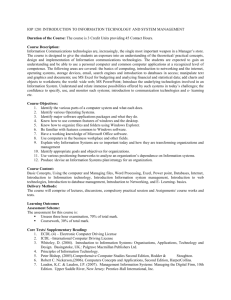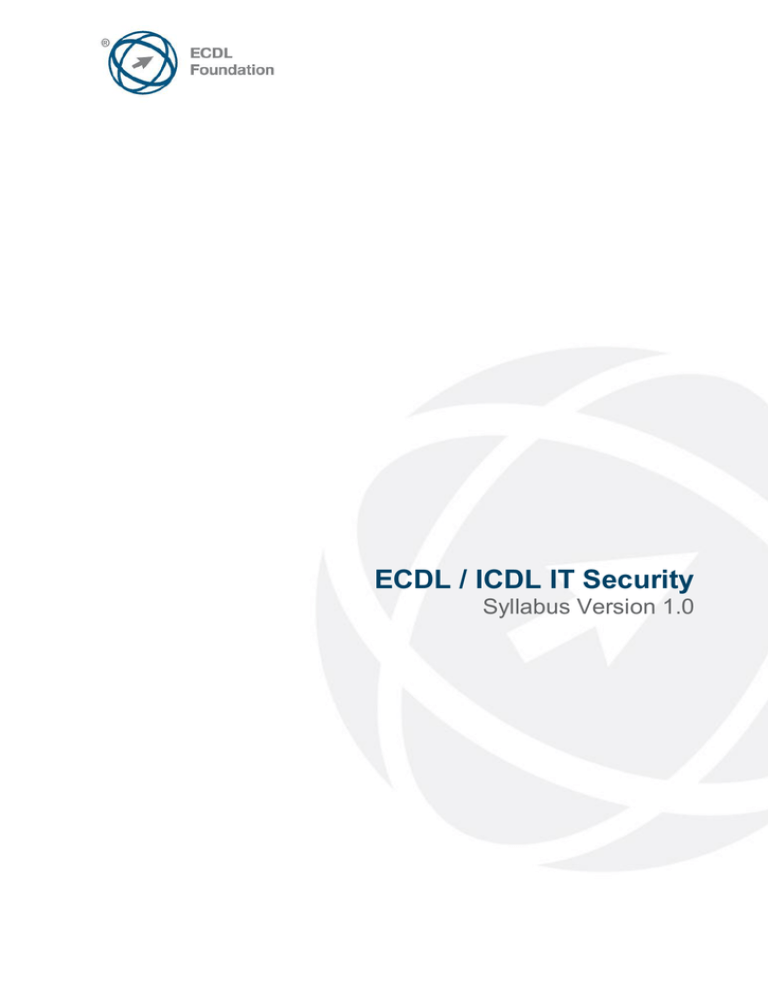
ECDL / ICDL IT Security
Syllabus Version 1.0
Purpose
This document details the syllabus for ECDL / ICDL IT Security. The syllabus
describes, through learning outcomes, the knowledge and skills that a candidate for
ECDL / ICDL IT Security should possess. The syllabus also provides the basis for the
theory and practice-based test in this module.
Copyright © 2010 ECDL Foundation
All rights reserved. No part of this publication may be reproduced in any form except
as permitted by ECDL Foundation. Enquiries for permission to reproduce material
should be directed to ECDL Foundation.
Disclaimer
Although every care has been taken by ECDL Foundation in the preparation of this
publication, no warranty is given by ECDL Foundation, as publisher, as to the
completeness of the information contained within it and neither shall ECDL
Foundation be responsible or liable for any errors, omissions, inaccuracies, loss or
damage whatsoever arising by virtue of such information or any instructions or advice
contained within this publication. Changes may be made by ECDL Foundation at its
own discretion and at any time without notice.
ECDL Foundation is a registered business name of The European Computer Driving Licence Foundation Limited and ECDL Foundation
(International) Limited. European Computer Driving Licence, ECDL, International Computer Driving Licence, ICDL, and related logos are all
registered Trade Marks of ECDL Foundation. All rights reserved.
© 2010 ECDL Foundation
Ref: ECDL / ICDL IT Security - Syllabus - V1.0
Page 2 of 9
ECDL / ICDL IT Security
This module sets out essential concepts and skills relating to the ability to understand the
main concepts underlying the secure use of ICT in daily life and to use relevant techniques
and applications to maintain a secure network connection, use the Internet safely and
securely, and manage data and information appropriately.
Module Goals
Successful candidates will be able to:
Understand the key concepts relating to the importance of secure information and
data, physical security, privacy and identity theft.
Protect a computer, device or network from malware and unauthorised access.
Understand the types of networks, connection types and network specific issues
including firewalls.
Browse the World Wide Web and communicate on the Internet securely.
Understand security issues related to communications including e-mail and instant
messaging.
Back up and restore data appropriately and safely, and securely dispose of data and
devices.
CATEGORY
SKILL SET
1 Security Concepts1.1.1 Data Threats
1.2 Value of Information
© 2010 ECDL Foundation
REF.
TASK ITEM
1.1.1
Distinguish between data and
information.
1.1.2
Understand the term
cybercrime.
1.1.3
Understand the difference
between hacking, cracking and
ethical hacking.
1.1.4
Recognise threats to data from
force majeure like: fire, floods,
war, earthquake.
1.1.5
Recognise threats to data from:
employees, service providers
and external individuals.
1.2.1
Understand the reasons for
protecting personal information
like: avoiding identity theft,
fraud.
Ref: ECDL / ICDL IT Security - Syllabus - V1.0
Page 3 of 9
CATEGORY
SKILL SET
1.3 Personal Security
1.4 File Security
© 2010 ECDL Foundation
REF.
TASK ITEM
1.2.2
Understand the reasons for
protecting commercially
sensitive information like:
preventing theft or misuse of
client details, financial
information.
1.2.3
Identify measures for
preventing unauthorised access
to data like: encryption,
passwords.
1.2.4
Understand basic
characteristics of information
security like: confidentiality,
integrity, availability.
1.2.5
Identify the main data/privacy
protection, retention and control
requirements in your country.
1.2.6
Understand the importance of
creating and adhering to
guidelines and policies for ICT
use.
1.3.1
Understand the term social
engineering and its implications
like: information gathering,
fraud, computer system access.
1.3.2
Identify methods of social
engineering like: phone calls,
phishing, shoulder surfing.
1.3.3
Understand the term identity
theft and its implications:
personal, financial, business,
legal.
1.3.4
Identify methods of identity theft
like: information diving,
skimming, pretexting.
1.4.1
Understand the effect of
enabling/ disabling macro
security settings.
1.4.2
Set a password for files like:
documents, compressed files,
spreadsheets.
1.4.3
Understand the advantages
and limitations of encryption.
Ref: ECDL / ICDL IT Security - Syllabus - V1.0
Page 4 of 9
CATEGORY
2 Malware
SKILL SET
2.1 Definition and Function
2.2 Types
2.3 Protection
3 Network Security 3.1 Networks
3.2 Network Connections
© 2010 ECDL Foundation
REF.
TASK ITEM
2.1.1
Understand the term malware.
2.1.2
Recognise different ways that
malware can be concealed like:
Trojans, rootkits and back
doors.
2.2.1
Recognise types of infectious
malware and understand how
they work like: viruses, worms.
2.2.2
Recognise types of data theft,
profit generating/extortion
malware and understand how
they work like: adware,
spyware, botnets, keystroke
logging and diallers.
2.3.1
Understand how anti-virus
software works and its
limitations.
2.3.2
Scan specific drives, folders,
files using anti-virus software.
Schedule scans using anti-virus
software.
2.3.3
Understand the term quarantine
and the effect of quarantining
infected/suspicious files.
2.3.4
Understand the importance of
downloading and installing
software updates, anti-virus
definition files.
3.1.1
Understand the term network
and recognise the common
network types like: local area
network (LAN), wide area
network (WAN), virtual private
network (VPN).
3.1.2
Understand the role of the
network administrator in
managing the authentication,
authorisation and accounting
within a network.
3.1.3
Understand the function and
limitations of a firewall.
3.2.1
Recognise the options for
connecting to a network like:
cable, wireless.
Ref: ECDL / ICDL IT Security - Syllabus - V1.0
Page 5 of 9
CATEGORY
SKILL SET
3.3 Wireless Security
3.4 Access Control
4 Secure Web Use
© 2010 ECDL Foundation
4.1 Web Browsing
REF.
TASK ITEM
3.2.2
Understand how connecting to
a network has implications for
security like: malware,
unauthorised data access,
maintaining privacy.
3.3.1
Recognise the importance of
requiring a password for
protecting wireless network
access.
3.3.2
Recognise different types of
wireless security like: Wired
Equivalent Privacy (WEP), WiFi Protected Access (WPA),
Media Access Control (MAC).
3.3.3
Be aware that using an
unprotected wireless network
can allow wireless
eavesdroppers to access your
data.
3.3.4
Connect to a protected/
unprotected wireless network.
3.4.1
Understand the purpose of a
network account and how it
should be accessed through a
user name and password.
3.4.2
Recognise good password
policies, like: not sharing
passwords, changing them
regularly, adequate password
length, adequate letter, number
and special characters mix.
3.4.3
Identify common biometric
security techniques used in
access control like: fingerprint,
eye scanning.
4.1.1
Be aware that certain online
activity (purchasing, financial
transactions) should only be
undertaken on secure web
pages.
4.1.2
Identify a secure website like:
https, lock symbol.
4.1.3
Be aware of pharming.
Ref: ECDL / ICDL IT Security - Syllabus - V1.0
Page 6 of 9
CATEGORY
SKILL SET
4.2 Social Networking
5 Communications 5.1 E-Mail
© 2010 ECDL Foundation
REF.
TASK ITEM
4.1.4
Understand the term digital
certificate. Validate a digital
certificate.
4.1.5
Understand the term one-time
password.
4.1.6
Select appropriate settings for
enabling, disabling
autocomplete, autosave when
completing a form.
4.1.7
Understand the term cookie.
4.1.8
Select appropriate settings for
allowing, blocking cookies.
4.1.9
Delete private data from a
browser like: browsing history,
cached internet files,
passwords, cookies,
autocomplete data.
4.1.10
Understand the purpose,
function and types of contentcontrol software like: internet
filtering software, parental
control software.
4.2.1
Understand the importance of
not disclosing confidential
information on social
networking sites.
4.2.2
Be aware of the need to apply
appropriate social networking
account privacy settings.
4.2.3
Understand potential dangers
when using social networking
sites like: cyber bullying,
grooming, misleading/
dangerous information, false
identities, fraudulent links or
messages.
5.1.1
Understand the purpose of
encrypting, decrypting an email.
5.1.2
Understand the term digital
signature.
5.1.3
Create and add a digital
signature.
Ref: ECDL / ICDL IT Security - Syllabus - V1.0
Page 7 of 9
CATEGORY
SKILL SET
5.2 Instant Messaging
6 Secure Data
Management
6.1 Securing and Backing Up
Data
6.2 Secure Destruction
© 2010 ECDL Foundation
REF.
TASK ITEM
5.1.4
Be aware of the possibility of
receiving fraudulent and
unsolicited e-mail.
5.1.5
Understand the term phishing.
Identify common characteristics
of phishing like: using names of
legitimate companies, people,
false web links.
5.1.6
Be aware of the danger of
infecting the computer with
malware by opening an e-mail
attachment that contains a
macro or an executable file.
5.2.1
Understand the term instant
messaging (IM) and its uses.
5.2.2
Understand the security
vulnerabilities of IM like:
malware, backdoor access,
access to files.
5.2.3
Recognise methods of ensuring
confidentiality while using IM
like: encryption, non-disclosure
of important information,
restricting file sharing.
6.1.1
Recognise ways of ensuring
physical security of devices like:
log equipment location and
details, use cable locks, access
control.
6.1.2
Recognise the importance of
having a back-up procedure in
case of loss of data, financial
records, web
bookmarks/history.
6.1.3
Identify the features of a backup procedure like:
regularity/frequency, schedule,
storage location.
6.1.4
Back up data.
6.1.5
Restore and validate backed up
data.
6.2.1
Understand the reason for
permanently deleting data from
drives or devices.
Ref: ECDL / ICDL IT Security - Syllabus - V1.0
Page 8 of 9
CATEGORY
© 2010 ECDL Foundation
SKILL SET
REF.
TASK ITEM
6.2.2
Distinguish between deleting
and permanently destroying
data.
6.2.3
Identify common methods of
permanently destroying data
like: shredding, drive/media
destruction, degaussing, using
data destruction utilities.
Ref: ECDL / ICDL IT Security - Syllabus - V1.0
Page 9 of 9

